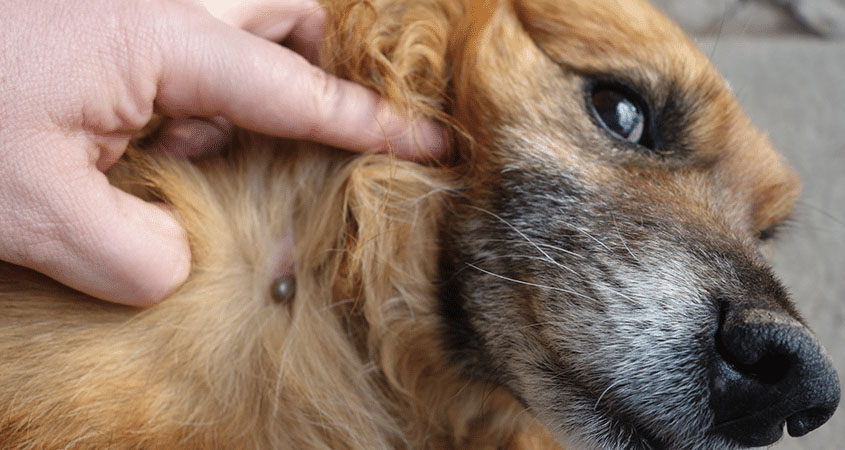What to Do if You Find a Tick on Your Dog
If your dog spends time playing outdoors, he will likely come into contact with ticks. While the thought of a tick on your beloved pup may cause you to cringe, removing a tick is a fairly easy process to do. Today, we’ve put together a step-by-step guide on what to do if you find a tick on your dog and tips for preventing ticks in the future.
Because a dog tick bite can cause a number of issues, including dog tick diseases, it’s necessary to know what a tick on a dog looks like and, most importantly, how to properly remove a tick on your dog.
If you’re unsure how to remove a tick from your pup, you have come to the right place. Here you will learn how to remove a tick on your dog, ways to prevent ticks, and certain dog tick diseases to be aware of.
Ready to learn the steps to remove a tick from a dog? Read on to learn how to remove a tick from your pup and how to properly care for a dog tick bite.
What Does a Tick Look Like on a Dog?
Before we explain how to remove a tick from your dog, it’s important for dog owners to understand what a tick looks like when attached to your dog’s skin. Ticks are incredibly tiny creatures, making them extremely difficult to notice until they have become engorged with blood. A tick that has been embedded on a dog for several days may swell up to several times its original size, although even then it can still be difficult to notice.
The colors of ticks range from black and brown to gray and tan. Although a tick may appear anywhere on your dog’s skin, most ticks seek a dark, warm environment for engorging themselves with blood. This includes under your dog’s front legs, in between the toes, around the groin area, inside the ears, around the neck, and near your dog’s eyes.
Because certain species of ticks can be as small as the head of a pin, you can’t rely on eyesight alone to spot ticks on your dog. The best way to search for ticks is to run your fingers over your dog’s entire body, paying close attention to swollen areas and small bumps. Also note any redness or irritated spots on your dog’s skin.
How to Remove a Tick from Your Dog
Once you’ve spotted a tick on your dog, the next step is to properly remove it. To remove a tick on a dog, you will need a pair of gloves, clean tweezers, a disinfectant, and a small container filled with alcohol. Alternatively, you may use a tick remover, a special tool designed to detach ticks from skin.
When removing a tick from a dog, avoid coming in contact with the tick. Never use your fingers to remove a tick from your dog’s body. Only use tweezers to remove the tick, and always wear gloves. If you happen to touch the tick with your hands, wash your hands immediately afterward with soap and water.
Use tweezers to take the tick off your dog.
Because an infected tick can transmit disease in only a few hours, it’s important to wear latex gloves as you remove the tick with tweezers. Once you have grasped the tick with the tweezers, pull gently until the tick has detached from the skin. Be careful not to squeeze the tick, as this can cause the tick to release infected body fluids through its mouth and thus increase your dog’s risk of infection.
After the tick is removed, wash your hands and gently clean the bite area with soap and warm water. You’ll also want to clean the tweezers with a disinfectant.
Place the tick in a small container of alcohol.
To ensure the tick doesn’t come in contact with your dog again, it’s important to properly get rid of the tick. This can be done by placing the tick in a small container of alcohol. Because testing may be required if your dog shows signs of illness, it’s important to save the tick in a container or plastic bag and write down the date you found it on your dog.
Never try to burn, smother, or otherwise try to get a tick to “back out.”
When removing a tick from a dog, never use a lighter to burn a tick on your dog’s skin. Similarly, don’t try to smother a tick with nail polish, gasoline, petroleum jelly, or rubbing alcohol. Burning and smothering a tick attached to your dog will cause the tick to release harmful fluids that can increase your dog’s chance of becoming infected.
Even when wearing gloves, you should never attempt to remove a tick with your fingers. Not only are you at risk for getting bit, but it can cause the tick to regurgitate more potential pathogens into the dog’s skin.
How to Prevent Ticks on Dogs
Although it is quite impossible to get rid of ticks for good, there are many steps you can take to prevent ticks on dogs and protect your dog’s health. Mowing your lawn, vacuuming your floors, and washing pet bedding frequently can greatly reduce the number of ticks your dog may come in contact with. Moreover, brushing your dog often and routinely checking your dog’s body for ticks can prevent illnesses and infections caused by ticks.
An additional option is to ask your veterinarian for a flea and tick prevention product. Flea and tick preventatives are essential for your dog’s health if he spends much of the day outside at dog parks or in your backyard.
Dog Tick Diseases
Different species of ticks carry a number of dog tick diseases. The following list is just a few of the many tick-borne diseases that can affect your dog’s health:
- Lyme Disease
- Rocky Mountain Spotted Fever
- Ehrlichiosis
- Babesiosis
- Anaplasmosis
- American Canine Hepatozoonosis
If your dog shows any signs or symptoms of illness, consult your vet immediately. Not only may your pup suffer from dog tick diseases, but he may experience infection if the dog tick bite isn’t cleaned properly.











